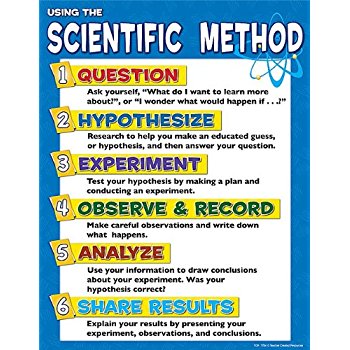Scientific Method
The Scientific Method - Solving Scientific Problems
MINDS ON
Solving a Problem...Science Style!
Review the following image that outlines the key steps of the Scientific Method.

Applying the Science Method
How do scientists Jamie Hyneman and Adam Savage use the Scientific Method as they investigate the validity of the Neil Armstrong’s Apollo 11 moon landing?
 TIP - Two Column Graphic Organizer
TIP - Two Column Graphic Organizer
- Watch the video, while having the Two Column Graphic Organizer in a split-screen (on your computer) to jot down your ideas and reactions.
- When you have completed the Two-Column Graphic Organizer, SAVE the document in such a way that you can refer to it later.
- When saving documents ensure you have named the file with a meaningful title so you can refer back to it easily.
Forming a Testable Question
The very basis of science is based on making an observation and asking the question Why? However some questions cannot be answered through an experiment. For example why do most teachers grade assignments using a red pen? Scientific exploration requires a testable question that can be answered by designing and conducting an experiment.
For example:
- What type of fertilizer will make grass grow the quickest?
A non-testable question cannot be answered by conducting an experiment; rather information can be researched and collected to support a response.
For example:
- What is the flu?
 What was the MythBusters' Testable Question?
What was the MythBusters' Testable Question?
- Review your notes from the MythBusters - Moon Landing Video.
- What was the testable question that Jamie and Adam are investigating?
ACTION
What do you see?
Watch the following demonstration. Have a piece of paper handy to record your observations. You will be prompted to pause the video at various times to note your observations.
Let’s review some comments that you may have noted during this demonstration.
- The candle is cylinder shaped.
- The candle produces a flame.
- The candle is a solid.
- The candle produces heat.
- The candle is a yellow-cream colour.
- The candle is waxy.
- The candle has a black wick.
- The object on the table is a candle.
Are these statements only observations?
U1A2ObservationInferences
Observations and Inferences
Scientists make observations throughout an investigation, so that they can further analyze what they have witnessed and make inferences as to whether their hypotheses are supported.
Observations and inferences are the foundation of scientific investigation.
Review the examples shown in the chart below:
|
Observation
|
Inference
|
|
“The ground is wet” |
“It likely rained last night” |
|
“That person is running” |
“Someone could be chasing them” |
|
“The liquid is clear and colourless” |
“The liquid is water” |
 Now You Try! Observe and Infer.
Now You Try! Observe and Infer.
- Review the pictures below and consider what you observe and what you could infer about the image.
- Choose three (3) images and write down your observations and inferences
- Now go back to the images and suggest an alternative inference for the three images that you choose initially
- Practice using the Observation/ Inference Graphic Organizer to more clearly organize and format your work.
Observations and Inferences
 TIP - Save Your Work
TIP - Save Your Work
- When you have completed the Observation and Inference Graphic Organizer, SAVE the document in such a way that you can make reference to it later.
- When saving documents ensure you have named the file with a meaningful title so that you can refer back to it easily.
Variables
Scientists must consider variables that can impact or influence the outcome of an investigation.

Often when trying to determine which variable you are considering, ask yourself these questions:
 Questions
Questions
- What can be changed in a science experiment?
AnswerIndependent Variable.
- What can be tested and measured?
AnswerDependent Variable.
- What can be controlled and kept the same?
AnswerControlled Variable.
 TIP - Save Your Work
TIP - Save Your Work
- The graphic showing information about variables may be a good resource to reference later on in the course.
- Take a screenshot and SAVE the document in such a way that you can refer to it later.
Identifying Variables
Now it is your turn!
Let’s practice identifying types of variables in example investigations.
General instructions for the interactive below:
- Click on each picture to read the scenario.
- For each scenario identify the following:
- Independent variable
- Dependent variable
- Control variable
U1A2IdentifyingVariables
The Scientific Method
Let’s put our new skills of observing, inferring and identifying variables together in one problem-solving process called the Scientific Method.
Review the graphic image that illustrates the key steps of the Scientific Method:

Using the Scientific Method
Let's dissect the Buzz on Energy Drinks investigation and identify how Richard the Scientist used the Scientific Method to investigate the impact of Energy Drinks on an individual's energy level.